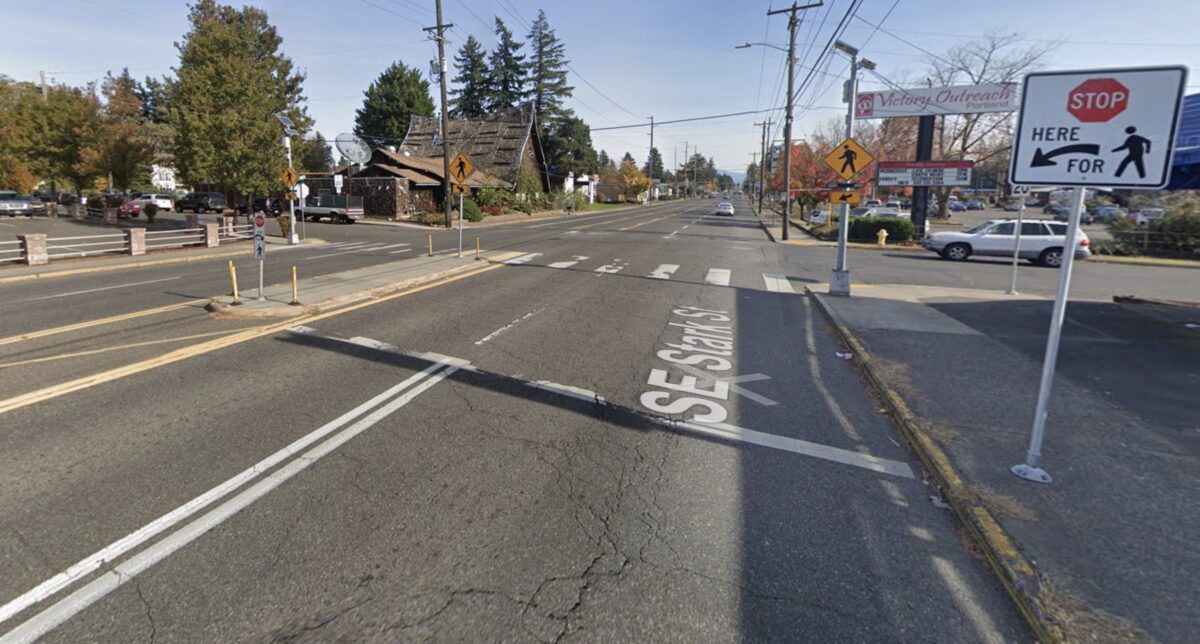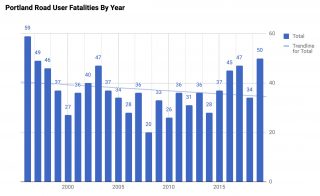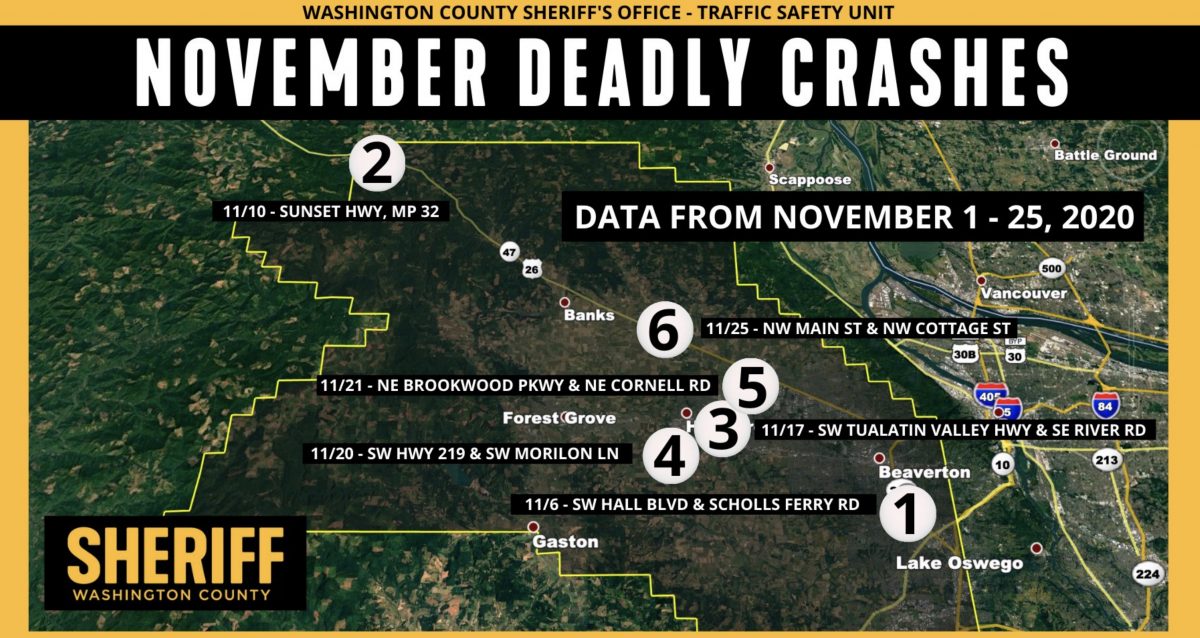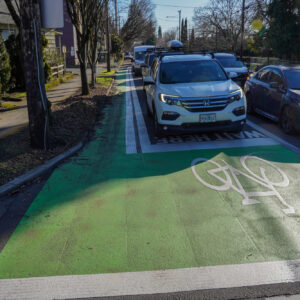

Despite our Vision Zero plans, projects, and proclamations, the Portland region is failing to curb traffic deaths. The City of Portland and Multnomah and Washington counties are grappling with alarming spikes and fatality trends in 2020 — even with a major traffic reduction due to the pandemic and with four more weeks left in the year.
The Portland Police Bureau announced over the weekend that 27-year-old Daniel Lopez-Herrera died in the hospital on Friday. On November 17th just before 7:00 pm, Lopez-Herrera was walking in the painted crosswalk on SE Stark at 160th (in photo above). That location is a well-known danger spot and Lopez-Herrara was using a crossing treatment that was installed just two years ago. Despite this “safer” crossing, he was struck by someone driving a car. The driver didn’t stop to render aid and police are still trying to find them. Lopez-Herrera left behind a wife and three young kids who are devastated by the loss of their father.

According to our tracker, Lopez-Herrera is the 50th person to die while using Portland streets so far this year. This equals our 2019 total, which was the highest number of fatalities recorded by the City of Portland since 1997. Four people have died on a 1.8-mile stretch of SE Stark Street in the past four months.
Advertisement
Zoom out to the county level and the picture looks just bad.
Communications Director for the Multnomah County Sheriff’s Office Chris Liedle says fatalities are up 41% so far in 2020 compared to 2019. According to Liedle, the East County Vehicular Crimes Team (ECVCT) — a specially trained unit with members from the Multnomah County Sheriff’s Office, Gresham Police Department and Multnomah County District Attorney’s Office that investigates serious and fatal vehicle crimes and crashes in Gresham, Fairview, Maywood Park, Troutdale, Wood Village and unincorporated Multnomah County — has recorded 24 deaths this year. Between 2016 and 2019 the ECVCT recorded 14 fatalities per year on average.
“Multnomah County has seen an increase in traffic fatalities on our roads this year,” County spokesman Mike Pullen shared this morning. “It seems counterintuitive, because we know there are less drivers on the road this year due to the pandemic… These grim fatality statistics should remind all of us that we need to use caution and obey traffic laws if we want to get home safely.”
Advertisement

Last week the Washington County Sheriff’s Office released a statement saying November, “Has been a particularly dangerous month.” The statement was spurred by six fatal crashes in 19 days. The most recent one on November 25th happened when a man driving a Dodge Caravan hit and killed 79-year-old Carol Goeden while she walked across a street in North Plains. It happened at a quiet intersection and the driver stopped at a stop sign prior to the collision. “The van’s windshield may not have been fully defrosted at the time, obscuring the driver’s view,” said the Sheriff’s Office, who cited the driver for careless driving and driving without a license.
Statewide numbers also paint a grim picture. Despite hundreds of thousands of fewer trips due to the pandemic Oregon is on pace for one of its deadliest years on record. As of today 439 people have died on Oregon roads, just 2% lower than the total at this time last year. Despite a stated focus on safety, the yearly trends are headed in the wrong direction. Between 2012 and 2015 an average of 332 Oregonians died on our roads. Between 2016 and 2019 Oregon averaged 436 traffic fatalities per year — a 31% increase from the previous four-year period.
These numbers should be a wake-up call to agencies, elected officials, policymakers and advocates. As I shared last month, we are saying and doing a lot to address this issue, but it’s not nearly enough. It’s time to get uncomfortable and do bigger — potentially more controversial things — to address this public health and safety crisis.
— Jonathan Maus: (503) 706-8804, @jonathan_maus on Twitter and jonathan@bikeportland.org
— Get our headlines delivered to your inbox.
— Support this independent community media outlet with a one-time contribution or monthly subscription.






Thanks for reading.
BikePortland has served this community with independent community journalism since 2005. We rely on subscriptions from readers like you to survive. Your financial support is vital in keeping this valuable resource alive and well.
Please subscribe today to strengthen and expand our work.
Maybe we can start with the radical idea of enforcing traffic laws. I don’t think I’ve seen a vehicle pulled over in Portland for a traffic violation in the last 10 years. I see cars pulled over in the suburban cities all the time.
Enforcement is biased.
Glad I know you’re being sarcastic. In Portland any enforcement of laws is considered racist so anarchy reigns supreme. The city will reap what it sows.
I mean, part of this article is highlighting how bad November was in Washington County, which does have plenty of cops and as you said, they enforce traffic laws.
The driver who killed Carol Goeden didn’t even have a license when they killed her and all they got was a ticket for careless driving and driving without a license.
The reality is that driving is considered a god-given right in this country and there just really aren’t consequences for killing someone as a long as you are behind the wheel and not drunk.
If you want people to follow the laws, there have to be real consequences for breaking them. Everything else is just revenue for the cops so they can buy another tank.
I’m surprised you would make such a statement, and I’m not sure I agree.
Driving errors are frequent, and almost always harmless, carrying a tiny probability of enormous consequence. So we could go with 1) Draconian punishments, proportional to the worst outcomes, of a) all small errors; or b) only those small errors that are unlikely enough to have bad outcomes; 2) Stick with punishments proportional to the error itself without regard to the actual consequences (which can appear to let people “get away with murder”); 3) Constant surveillance to ensure all small errors are detected and punished appropriately (i.e. heavy and absolute enforcement)
I think the real solution is to reimagine our transportation infrastructure so it doesn’t have the same properties (which will be a slow, and very expensive, prospect), but it’s a process I think we’ve started with advent of robot cars.
I think it’s going to be mostly bad news on the safety front for a while, but that it will get better, and once improvement starts, I think it will accelerate quickly.
* Tens of thousands of Portlanders will be evicted or forced to vacate for economic reason resulting in a catastrophic increase in people living outside.
* The housing crisis will accelerate demographic changes that further deplete Portland of frequent transit riders and people who bike/walk for transportation.
* Severe funding deficits will cause Trimet and other transit agencies to issue draconian cuts in services resulting in increased strain on transit users.
* Transit system delays will result in increased use of Uber and Lyft by those who can afford occasional use.
* Many economically stable people will switch to single occupancy vehicles due to pandemic-associated behavior change and reluctance to use an increasingly strained system.
* The shift away from physical retail will accelerate translating into further increases in delivery vehicle traffic
* These demographic shifts away from transportation alternatives will increase automobile density, anxiety of road users, harassment of non-automobile road users, and the rate of severe injuries of non-automobile users.
* Transit and bike mode share will hit generational lows.
Protected bike lanes would calm SE Stark nicely.
That plus a road diet would work even better, but both would push traffic to Burnside, Glisan, and the 4M. What we really need to do is also reduce the overall volume of car traffic by getting folks to use alternatives, take fewer trips, and reduce cut-through traffic, and divert fast traffic to I-84.
Burnside and Glisan should have protected bike lanes too.
I have said this before, but I-84 east of I-205 is not a viable alternative for travel in Outer SE Portland. Because of the jog north at 205, 84 is almost 2 miles north of Stark, and there are limited entry and exit points. For example, we live off NE Glisan & 60th, so super-easy access to 84. My in-laws live off SE 148th and Division. We will take Division, Burnside, or Glisan to get to 148th; taking I-84 would be 33% longer, both time and distance-wise. And taking transit is an hour vs. a 15 minute drive.
This topic is continually frustrating and depressing, but I appreciate BikePortland covering it.
IMHO – it’s actually not surprising there would be less traffic and yet more fatalities. A lower car-to-road ratio just means the remaining drivers are able to go faster, and faster traffic means deadlier crashes. It’s for this reason that ODOT’s desire to widen every road or freeway they can find is unconscionable.
Okay, so crashes are happening at roughly the same rate but are just deadlier now? Is that what we see in the data?
This seems to correlate with the roughly 600%, 700%, and 800% increases in speeding violations at 21-30 over, >30 over, and >100 mph citations respectively that were handed out just through early April 2020, compared to what were issued during the same time in 2019.
Often, traffic is the greatest traffic-calmer.
Tragic! Not surprised though given the lack of enforcement in Portland. We have defunded the police. They can barely keep up with 911 calls let alone enforce traffic laws.
Are you suggesting that a reduction in police budget has had an effect on the number of road deaths?
I am suggesting that cutting the police budget (which has already occurred) and not prosecuting many of their appropriate arrests has allowed an aura of lawlessness to be created in Portland. This has encouraged many criminals. Violent crimes (shootings, murders) are up. Elected officials are being harassed in their homes. Property crimes are up (vandalism, car theft, catalytic converter theft, package theft, etc). Chief Lovell has stated if the further cuts (proposed by the extreme leftist commissioner Joan Hardesty) are enacted the ENTIRE Traffic division would be eliminated. With the increase in crime the police are forced to prioritize violent crimes and shift their focus away from less acute violations of the law such as traffic violations. Yes, less enforcement means higher speeds and therefore more injurious crashes resulting in more deaths,
Portland is no longer the “City that works”. It is now the “City that enables”.
The data does not support your opinion. Here are the last few years of road deaths in portland. 2016 had 42, 2017 had 47. 2018 had 34. 2019 51 and this year 50 thus far. Road deaths have had an upward trend generally, but there is no evidence a recent budget change could have had any affect on “making higher speeds and therefore more injurious crashes resulting in more deaths.” There is recent evidence suggesting that there has been a reduction in the number of people speeding 5mph over the limit.
Unfortunately, due to all the variables not accounted for it is impossible to use the data set you reference to prove or negate the point. However, Res ipsa loquitur (the thing speaks for itself) applies in this situation. Reduction of funding to police equals less enforcement equals higher traffic speeds equals more injurious collisions equals more traffic deaths.
All of which are assumptions with no evidence to support.
The police obviously have plenty of resources for harassing protesters and houseless. It’s not a matter of funding, but priorities.
That is the new Portland narrative that is being repeated over and over until people actually believe it. Do you have any evidence that the police are harassing the homeless/houseless? I don’t think there is any. There is evidence that they have less staffing and that 911 response times are longer. In my opinions, vilifying an entire class of people (police officers) does not help move the conversation forward in a positive direction.
The traffic division has always been understaffed, so you seem to be confounding total staffing shortages that are not related to traffic enforcement.
Regardless of the staffing levels of the various departments, police funding cuts will amplify current staffing shortages. Traffic division will be disproportionately affected as it is viewed as focusing on “non-violent” crime. Of course traffic collisions are violent but are “less violent” than gun violence, shootings, rapes etc.
Dispassionate video on PPB staffing
https://www.youtube.com/watch?v=hhx_8DVE3WI
I’ve pretty much resigned myself to this new grim reality until the robot cars arrive.
Be careful out there!
In addition to cars driving faster with more room on the road, I suspect fewer bikes and peds may result in drivers not looking for people as much. That’s just my impression from looking around and seeing things closed/boarded up and transit not getting much use lately.
Well, in 20 years the Portland User Fatality trendline has dropped from 37 to 34. I guess that’s an “improvement” but certainly not enough of one. At that rate it’ll take over 200 years for us to get to zero. Time for some real change towards Vision Zero. It’ll likely take a top down change at the federal level, requiring auto manufacturers to design for pedestrian safety, and minimizing distracted driving, which infotainment systems don’t help with at all.
If you key it to population growth, Portland population went up 23% between 1997 and 2019, so if nothing had changed you would expect that trendline to increase to ~45. The fact that it’s gone down at all indicates an actual improvement. Not that 50 deaths, or 1 death, should be acceptable, just giving some context.
Population growth can have virtually no affect on road deaths. Oslo and Helsinki both had substantial growth and reported virtually no road deaths. Design streets for safety, not car capacity, speed and parking, and road deaths plummet.
We need to stay on daylight savings time all year long. Dark roads during 5pm rush hour (often with rain obscuring visibility as well) is definitely not helping.
How will a 6pm dusk help on a pedestrian death close to 7pm?
It wouldn’t in that case, but it could help prevent deaths during rush hour, when more people are driving/walking/cycling all over the city.
TRUE
FALSE
The City of Portland, Metro, PBOT and relevant stakeholders are doing things that are not controversial while actively avoiding more controversial policy changes with greater evidence of effectiveness.
Sverige: Nollvisionen
Hamnland: Trafikvåld som vanligt
Jonathan, do you have access to the total number of reported collisions (including non-fatal) for the same time/area? That might give a indication if it is speed/reduced traffic related, or part of an overall trend.
PBOT gets fatal crash reports as a result of the PPB crash team that investigates them. Police only report other crashes that include medical transport and to which they were called. ODOT crash data like you are looking for lags by 2+ years. Also recall that reporting thresholds eliminate many property damage only crashes that might indicate an issue before injury crashes mount.
I did a little research and I was actually thinking of the DMV reports. I know those are self-reported, but I’m looking for trends more than absolute numbers. Are those separate from the ODOT data, or the same?
https://www.portland.gov/transportation/planning/safer-outer-stark
PBOT has a funded safety and repaving project in the pipeline for this section of Stark. Funded in 2017 (about $20 million) with no start date on the project. PBOT continually delays building funded projects in Outer East Portland. I suppose High Crash Corridors in East Portland are not the most pressing projects for the city. Most of the High Crash corridors are in Outer East Portland as well as 28 0f the top 30 High Crash intersections.
The bike/ped deaths are the most discouraging. I feel terrible for the family.
You are misstating the funding and timeline. The legislation that partially funds the project was enacted in 2017, money was not provided then. The project is funded from several sources, as stated on the link you provided. Money is provided over time. The planning began in 2019. Large projects are often phased, with involvment/design one year and construction the next.
Your statement about the location of high crash corridors is also untrue:
https://www.portland.gov/transportation/vision-zero/high-crash-network
At least you got the intersection information correct.
I “went” to last month’s meeting for the upcoming state highway safety plan. Since we’re not meeting the 2016 plan’s 5-year performance targets for reducing fatalities and serious injuries (they’re going up instead) ODOT staff recommends deleting the targets.
I believe change for safe streets will happen when laws are made that hold motorists responsible for their driving behaviors. When a crash occurs, a vulnerable person is killed, the driver committed murder.
The driver chose to speed, drive intoxicated, drive while visibility is compromised (frost on windshield), etc. The fear of real consequences will deter bad driving more than threat of ticket!